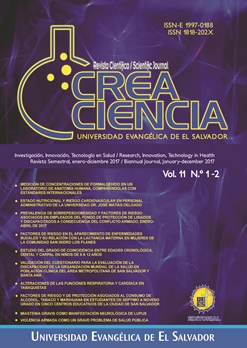Study of the degree of coincidence between chronological, dental and carpal age in children aged 8 to 12 years
DOI:
https://doi.org/10.5377/creaciencia.v11i1-2.6039Keywords:
Chronological age, dental age, carpal age, El Salvador.Abstract
The objective of the present radiographic and clinical study of a descriptive observational group was to determine the degree of coincidence between chronological, dental radiographic and carpal ages in a population of 40 children (20 boys and 20 girls), whose ages range from 8 to 12 years, that met the inclusion criteria of the investigation. Fo the collection of the information, weight, height and panoramic radiography were taken from the right hand of the 40 participants, who also underwent clinical dental inspection and taking intraoral clinical photographs. To determine carpal age, the Greulich and Pyle Atlas was used as reference; for obtaining radiographic age, the Demirjian method; the information on height and weight was used to determine size and BMI according to age with the help of standardized growth charts according to the average growth in the Salvadorean population.Through the Sudent´s T test, it was identified that, according to the medias obtained, there was a significant difference between the dental, carpal and chronological radiographic ages in the majority of the populationnstudied. In addition, it was observed that carpal age is found in most girls, increased with respect to chronological age; however, in children it is diminished. Only 20% were identified in each of the population groups studied with early dental replacement.
CREA CIENCIA Vol. 11 No 1-2 ISSN 1818-202X enero-diciembre 2017, p. 40-52
Downloads
2145
Downloads
Published
How to Cite
Issue
Section
License
© Crea Ciencia
Declaration of originality and assignment of rights
The article must be sent with a declaration of originality, responsibility and assignment of rights of copy of the manuscript, scanned and signed by the author or by one of the authors when the authorship is collective (designated author), stating that the text has not previously published in printed or electronic format, which will not be presented to any other media before knowing the decision of the journal Crea Ciencia and that, if accepted for publication, the authors transfer the copyrights in all forms and media known. At the end of six months of the publication, the text can be shared in another magazine citing the first version of the article published in Crea Ciencia and recording its number and volume. If the article is not published, the UEES agrees to return the rights enunciated to their authors.

Crea Ciencia articles are published in open access and licensed under a Creative Commons Attribution-NonCommercial 4.0 International License.

